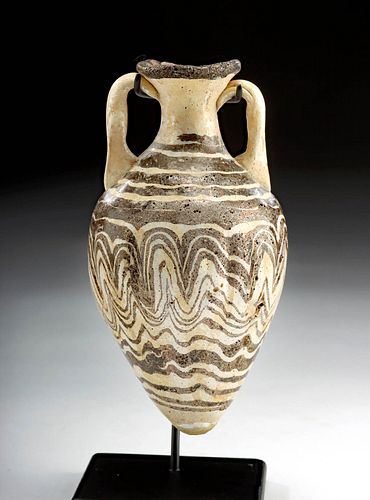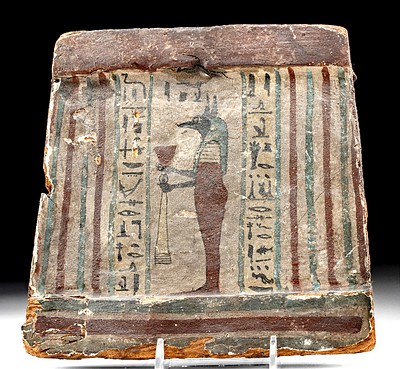Superb Greek Core-form Glass Amphoriskos
Lot 23b
About Seller
Artemis Fine Arts
686 S Taylor Ave, Ste 106
Louisville, CO 80027
United States
Selling antiquities, ancient and ethnographic art online since 1993, Artemis Gallery specializes in Classical Antiquities (Egyptian, Greek, Roman, Near Eastern), Asian, Pre-Columbian, African / Tribal / Oceanographic art. Our extensive inventory includes pottery, stone, metal, wood, glass and textil...Read more
Categories
Estimate:
$8,000 - $12,000
Absentee vs Live bid
Two ways to bid:
- Leave a max absentee bid and the platform will bid on your behalf up to your maximum bid during the live auction.
- Bid live during the auction and your bids will be submitted real-time to the auctioneer.
Bid Increments
| Price | Bid Increment |
|---|---|
| $0 | $25 |
| $300 | $50 |
| $1,000 | $100 |
| $2,000 | $250 |
| $5,000 | $500 |
| $10,000 | $1,000 |
| $20,000 | $2,500 |
| $50,000 | $5,000 |
| $100,000 | $10,000 |
| $200,000 | $20,000 |
About Auction
By Artemis Fine Arts
Aug 26, 2021
Set Reminder
2021-08-26 10:00:00
2021-08-26 10:00:00
America/New_York
Bidsquare
Bidsquare : Fine Antiquities | Asian | Ethnographic Art
https://www.bidsquare.com/auctions/artemis-gallery/fine-antiquities-asian-ethnographic-art-7366
Features classical antiquities, ancient and ethnographic art from cultures encompassing the globe. Egyptian, Greek, Roman, Etruscan, Near Eastern, Asian, Pre-Columbian, Native American, African / Tribal, Oceanic, Spanish Colonial, Russian, Fine / Visual Arts, so much more! Artemis Fine Arts info@artemisgallery.com
Features classical antiquities, ancient and ethnographic art from cultures encompassing the globe. Egyptian, Greek, Roman, Etruscan, Near Eastern, Asian, Pre-Columbian, Native American, African / Tribal, Oceanic, Spanish Colonial, Russian, Fine / Visual Arts, so much more! Artemis Fine Arts info@artemisgallery.com
- Lot Description
Greece, ca. 3rd century BCE. Absolutely stunning brown-on-white glass amphoriskos perfume vessel owned by a member of the elite class. Opaque white base glass to which a deep brown glass was intermixed with feathered pattern, with white handles and dark brown rim. Base narrows to rounded tip, rim flares to sloped opening. What truly sets this vessel apart from so many others we have handled is the incredible iridescent surface which absolutely sparkles! Size: 2.125" W x 4" H (5.4 cm x 10.2 cm); 4.75" H (12.1 cm) on included custom stand.
A vessel like this would have been made for the elites of ancient society. Its owner would have used a stopper to keep the contents inside, and a glass rod to dip into the vessel's perfumed oils and dab on the throat or wrists. The little handles made it possible to suspend the vessel, and we know from Athenian vase paintings that vessels like these could be worn off a belt at the waist or suspended from the wrist.
The Greeks created core-formed or sandcore vessels by trailing threads of molten glass over a "core" of sand or clay to form the vessel. These threads were oftentimes feathered or dragged to create intriguing decorative patterns. The term amphoriskos literally means "little amphora" and is indeed a miniature amphora. This shape was quite popular as it was ideal to store precious oils, perfumes, or cosmetics.
According to the Corning Museum of Glass, core forming is "the technique of forming a vessel by winding or gathering molten glass around a core supported by a rod. After forming, the object is removed from the rod and annealed. After annealing, the core is removed by scraping." (https://www.cmog.org/glass-dictionary/core-forming). This process of glass making was begun in the late 16th century BCE by glassmakers of Mesopotamia, and then adopted by Egyptian glassmakers in the 15th century BCE. The technique almost came to an end in the so-called Dark Ages of Mediterranean civilization (1200 to 900 BCE); however, by the 9th century BCE a new generation of glassmakers took up the technique once again, and between the 6th and 4th century BCE core-forming spread throughout the Mediterranean.
Provenance: Private European Collection, acquired in the late 1970s - early 1980s
All items legal to buy/sell under U.S. Statute covering cultural patrimony Code 2600, CHAPTER 14, and are guaranteed to be as described or your money back.
A Certificate of Authenticity will accompany all winning bids.
PLEASE NOTE: Due to recent increases of shipments being seized by Australian & German customs (even for items with pre-UNESCO provenance), we will no longer ship most antiquities and ancient Chinese art to Australia & Germany. For categories of items that are acceptable to ship to Australia or Germany, please contact us directly or work with your local customs brokerage firm.
Display stands not described as included/custom in the item description are for photography purposes only and will not be included with the item upon shipping.
#162415Minor erosion to rim, base appears to have been reattached with inner white "eggshell" glass exposed, thin chip to upper handle. Vessel has developed a stunning iridescence.Condition
- Shipping Info
-
All shipping is handled in-house for your convenience. Your invoice from Artemis Gallery will include shipping calculation instructions. If in doubt, please inquire BEFORE bidding for estimated shipping costs for individual items.
-
- Buyer's Premium



 EUR
EUR CAD
CAD AUD
AUD GBP
GBP MXN
MXN HKD
HKD CNY
CNY MYR
MYR SEK
SEK SGD
SGD CHF
CHF THB
THB
















